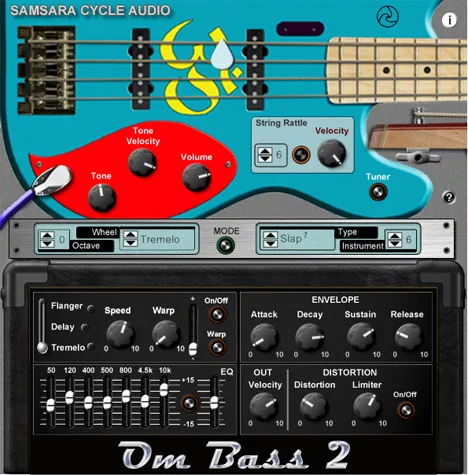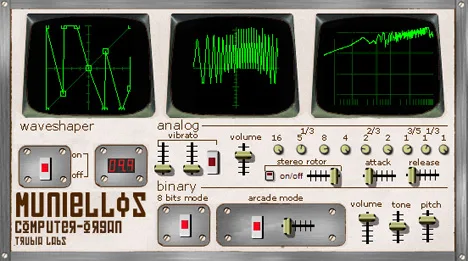Discover Monolisa – a free monophonic virtual analog synthesizer (VA Synth) from nB Audio. If you’re looking for an instrument capable of reproducing those warm, fat, and punchy sounds that have shaped electronic music for decades, Monolisa is a great addition to your plugin collection. This synthesizer is ideal for creating classic basslines, expressive leads, and unique sound effects. Despite its simplicity, Monolisa has all the necessary elements for flexible sound design.
Key Features of Monolisa
Monolisa is designed with an emphasis on an intuitive workflow and high-quality reproduction of vintage analog timbres. Each module of the synthesizer offers deep control over the sound.
VCO (Voltage Controlled Oscillators)
The heart of any analog synthesizer is its oscillators. Monolisa is equipped with two oscillators, each with its own set of capabilities:
- Osc1: generates classic waveforms – sawtooth (Saw) and square (Square).
- PWM (Pulse Width Modulation): available for the square wave of Osc1, allowing you to create rich, moving timbres. Modulation modes include manual control, envelope control, and LFO control.
- Semi-tune transpose: a semitone transposition function that links both oscillators for easy creation of harmonic intervals or powerful unison sounds.
- Osc2: offers additional sound sources – a sub-oscillator (Square) for adding depth to basses, as well as white (White) and pink (Pink) noise for creating percussive or atmospheric effects.
- Mixer: a special mixer allows you to precisely balance the levels of Osc1, Osc2, and noise, forming the basis of your sound.
VCF (Voltage Controlled Filter)
The Monolisa filter is a powerful tool for shaping timbre, capable of both removing unwanted frequencies and adding resonance for a characteristic “singing” sound:
- Filter types: includes 24dB Low-pass (low frequencies) for smoothing or muting highs, and 24dB Hi-pass (high frequencies) for cutting bass or creating radio/telephone effects.
- Cutoff and Resonance: the main controls for determining the cutoff frequency and adding resonance near that frequency.
- Envelope intensity: allows the intensity of the filter envelope’s effect on the cutoff frequency.
- Keyboard-tracking: a function that makes the filter cutoff frequency follow the pitch of the played note, ideal for creating more realistic or expressive timbres.
- ADSR Envelope: a classic envelope (Attack, Decay, Sustain, Release) with velocity sensitivity control, which allows you to dynamically change the filter over time.
VCA (Voltage Controlled Amplifier)
The VCA controls the final volume level and its change over time:
- Main Volume: overall control of the output signal volume.
- ADSR Envelope: its own ADSR envelope for VCA, also sensitive to velocity, which allows you to shape the sound dynamics from sharp attacks to smooth fades.
LFO (Low Frequency Oscillator)
Monolisa’s LFO adds movement and modulation to your sound:
- Shape: selecting the LFO waveform – Sine (sine wave), Saw (sawtooth), and Square (square wave).
- Frequency: modulation speed control.
- Modulation Source: the LFO can be synchronized with the filter envelope (VCF ADSR).
- Destinations: the LFO can modulate one or more parameters simultaneously – oscillators (VCO), filter (VCF), and amplifier (VCA), creating vibrato, wah-wah, tremolo, etc. effects.
Keyboard Controls
The keyboard section allows you to adapt the behavior of the synthesizer to your playing style:
- Trigger/Legato switch: switching between modes where each pressed note restarts the envelopes (Trigger) or the envelopes continue to sound with legato performance (Legato), ideal for smooth basslines or leads.
- Note Priority switch: selecting the priority for monophonic mode (e.g., last note played, highest or lowest).
- Portamento time: adjusting the portamento time – the smooth gliding of pitch between the played notes.
- Pitch-bend range: determining the range of the Pitch-bend wheel.
- Modulation-wheel intensity: adjusting the intensity of the modulation wheel’s effect on the assigned parameters.
Conclusion
Monolisa from nB Audio is a great example of how a free plugin can offer rich and musical sound. Its simple interface makes it accessible to beginners, while its flexible routing options and classic analog modules will satisfy more experienced sound designers. Whether you need a dense bass for an electronic track, a cutting lead for a solo, or an experimental sound effect, Monolisa has the potential to bring your ideas to life. Download it today and add classic monophonic sounds to your DAW on Windows!



